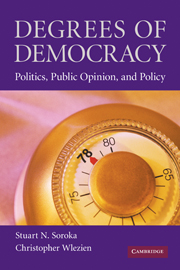Book contents
- Frontmatter
- Contents
- Preface
- Degrees of Democracy
- 1 Public Opinion and Policy in Representative Democracy
- 2 The Thermostatic Model
- 3 Adding Issues and Institutions
- 4 Public Preferences and Spending
- 5 Parameters of Public Responsiveness
- 6 Public Responsiveness Explored
- 7 Policy Representation
- 8 Disaggregating Public Responsiveness and Policy Representation
- 9 Degrees of Democracy
- Appendix
- Bibliography
- Index
6 - Public Responsiveness Explored
Published online by Cambridge University Press: 05 June 2012
- Frontmatter
- Contents
- Preface
- Degrees of Democracy
- 1 Public Opinion and Policy in Representative Democracy
- 2 The Thermostatic Model
- 3 Adding Issues and Institutions
- 4 Public Preferences and Spending
- 5 Parameters of Public Responsiveness
- 6 Public Responsiveness Explored
- 7 Policy Representation
- 8 Disaggregating Public Responsiveness and Policy Representation
- 9 Degrees of Democracy
- Appendix
- Bibliography
- Index
Summary
Chapter 5 demonstrated that public responsiveness to policy is pervasive. This is satisfying and important, and it provides a corresponding basis for policy representation. Before considering representation, however, this chapter probes further public responsiveness to budgetary policy, focusing on “to what” and “when” the public responds. It does so by addressing five issues related to public responsiveness, each an extension of the basic thermostatic hypothesis investigated in Chapter 5. The issues are in one sense rather disparate, and take the analysis of public responsiveness in different directions. But the results all do bolster the claim that what we have identified as public responsiveness to budgetary policy is actually that.
First, we examine the degree to which the public responds to policy decisions versus policy outputs, that is, to the making of budgetary policy versus to expenditures as they occur. Second, we explore when in the fiscal year the public responds; this also helps us understand to what the public responds, as we will see. Third, we consider whether the public is responding to the outcomes of spending policy rather than to spending itself. We examine, for example, the degree to which public responsiveness is focused on changes in crime spending or on changes in the crime rate. Fourth, we also explore the degree to which responsiveness in a federal context is focused on spending by a single government, versus the spending of multiple governments.
- Type
- Chapter
- Information
- Degrees of DemocracyPolitics, Public Opinion, and Policy, pp. 107 - 124Publisher: Cambridge University PressPrint publication year: 2009

